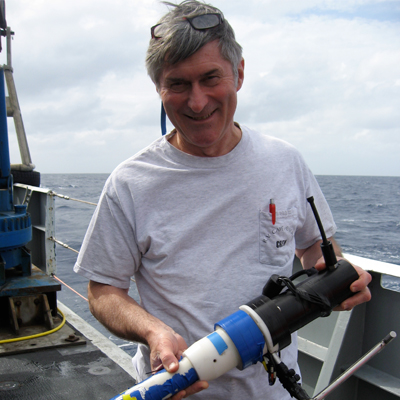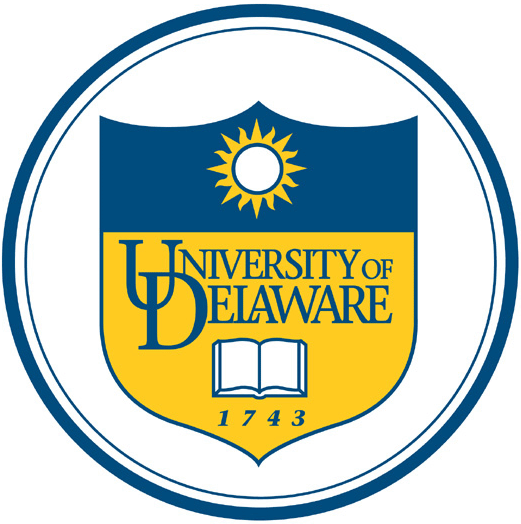Exploring the interaction of chemistry and (micro)biology at interfaces
Massive fish kills all over the east coast of the US as well as the Gulf Coast, are usually due to one of two factors: low oxygen or hydrogen sulfide. Toxic and corrosive, hydrogen sulfide in bottom stagnant waters, that also contain ammonium and phosphate and that can overturn during storm events, often result in fish kills and in harmful algal blooms. Dr. George Luther, Maxwell P. and Mildred H. Harrington Professor at the University of Delaware, documents the chemistry and biology of many different natural systems including stagnant basins, oxygen minimum zones, sediments, and hydrothermal vents. For example, Dr. Luther and his group discovered that adding compressed air to the intake of a hydroelectric power plant rapidly oxidized bottom water sulfide (in the presence of iron), so that the water placed back into the environment did not release hydrogen sulfide to the atmosphere due to oxidation of sulfide. By probing the chemistry of interfaces in the sediments and in the water column where oxygen, manganese, iron and sulfide interact including biological and chemical rates of reaction, Dr. Luther is able to offer solutions to remediate sediments.
Dr. Luther takes a physical inorganic chemistry approach to understand environmental problems of importance and relevance, engaging disciplines across geology, geochemistry, and (micro)biology to answer important long-standing questions about the environmental chemistry of multiple elements and the health of an ecosystem. His group has also developed a multi-analyte electrode sensor to measure various chemical species of oxygen, sulfur, iron and manganese simultaneously and in real time. Although they are at a very mature stage in their research, Dr. Luther and his group are always finding new environmental and microbial systems to study. In the last two to three years, they have been able to find two microbes of importance, an iron oxidizing bacterium, and a phototrophic sulfide oxidizing bacterium that exist in waters containing little or no oxygen, in the seasonally anoxic Chesapeake Bay. Their prominent track record and expertise allows Dr. Luther to collaborate with numerous companies to make measurements of sediments, in order to restore relevant systems and the natural environment back in order.
Current projects include:
- Developing Electrode Sensors: Dr. Luther and his group were the first to develop these particular electrode sensors, and Dr. Luther has been training people all over the world to produce the sensors and use them. The sensor is based on the electrochemical technique called voltammetry, where information about an analyte is obtained by measuring the current as the potential is varied. The electrodes can work in sediments and the water column, including freshwater, normal marine waters and brines. The team can use their redox electrochemical sensors to search for organisms that live in different redox chemistry niches, and obtain quantitative reaction rates and kinetic constants to understand how important these organisms are in their niches. Ultimately, Dr. Luther works to redesign the electrode sensor for different purposes and projects.
- Using Physical Inorganic Chemistry to understand the environment: Microbes use the energy from the reactions of the chemical compounds of certain elements to grow and thrive. Dr. Luther and his team use the fundamentals of physical inorganic chemistry along with the electrochemical redox electrode to document electron and chemical species flow in the environment. They are currently studying the natural processes related to chemosynthesis, photosynthesis, organic matter decomposition, or respiration, and other processes, so that when perturbations occur to an ecosystem, they can be understood and addressed. Ultimately, by measuring the health of an environment as well as the rate of chemical reactions, Dr. Luther hopes to develop strategies for biological, chemical or physical remediation of sediments and water columns once the chemistry and microbiology are known.
- Probing Nanoparticles: Nanoparticles are created both by pure chemical reactions in the environment and by the mediation of organisms. Dr. Luther and his team have discovered that natural pyrite nanoparticles emanating from hydrothermal vents are a source of iron to the organisms in the deep ocean, and that the formation of other metal sulfide nanoparticles is a detoxification mechanism for both the metal and the hydrogen sulfide in municipal waste waters. Dr. Luther has shown the catalytic cycle between oxygen, iron (or manganese) to detoxify sulfide, and hopes to gain a deeper understanding of the natural nanoparticles found in the environment to uncover their implications.
Bio
Dr. George Luther has always had a fascination with nature even though he grew up in the city of Philadelphia. That fascination was enriched with frequent summer visits to his grandparents’ house on the edge of a salt marsh in Wildwood, New Jersey. However, chemistry caught much of his intellectual attention, and he received his B.A. at La Salle College and his doctoral training in physical-inorganic chemistry at the University of Pittsburgh.
When he met more researchers studying the natural environment in the early 1980’s, Dr. Luther realized that he could take chemistry to solve nature and environmental problems. These researchers would frequently ask him chemistry questions that were relevant to their research, and usually his responses helped them to be more productive and elucidate the answers to the questions. Since he found himself enjoying this kind of approach, he shifted his focus from pure chemistry to environmental and Marine chemistry, and over the years he discovered that his chemical knowledge was useful in solving problems that microbiologists and other biologists were interested in.
“I haven’t taken a biology course since high school and I talk to biologists all the time,” he laughs. “I haven’t taken a course in geology, and I've won awards as a geochemist.” The secret to effective and useful science, Dr. Luther believes, is in listening carefully to people and identifying their needs. When he is able to offer solutions based on his expertise, then true collaborations form and drive the heart of science. Since then, he has never looked back, and continues to solve problems for not only those within the academia but also in the industry, impacting science all around domains.
For more information, visit http://www.ceoe.udel.edu/our-people/profiles/luther
In the News
Dr. George Luther was interviewed by the staff of Chemical & Engineering News, which highlighted his extreme chemistry work in the Nov. 3, 2008 issue. Chemical & Engineering News is the official weekly news magazine for this society of 150,000 chemists.
In 2009, Essential Science Indicators performed an analysis of geosciences' citations and discovered that George Luther had the highest percent increase in total citations in the field of geosciences between 1998 and 2008. This link features the interview.
Dr. Luther's group participated in the Alvin science verification dives from March 13 – 26, 2014. The following web site covered the cruise.


